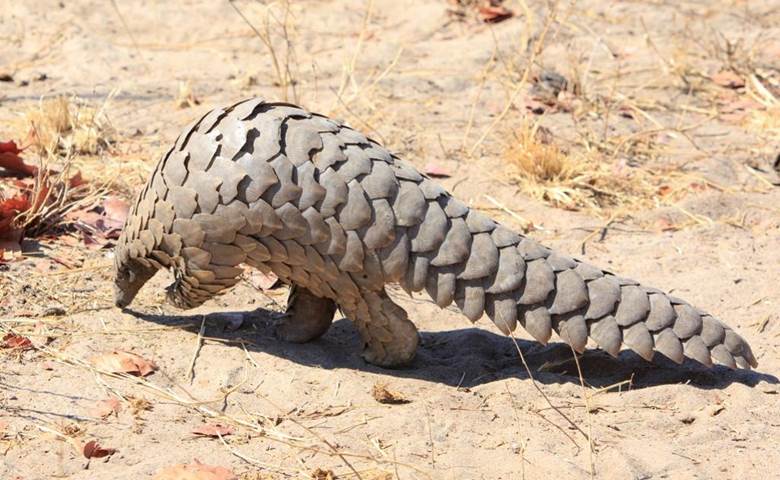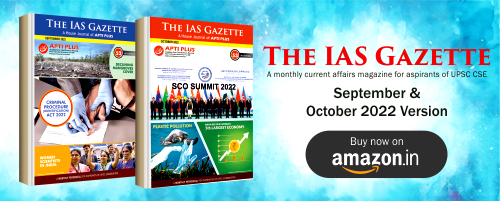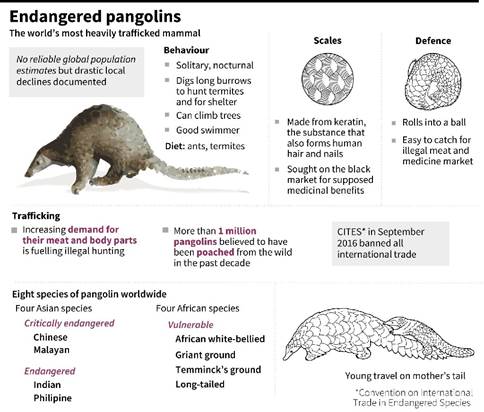Description

Copyright infringement not intended
Context: The 19th Conference of Parties (COP19) to the Convention on International Trade in Endangered Species of Wild Fauna and Flora (CITES) urged countries, to remove references to parts and derivatives of pangolins “from the official pharmacopoeia” to help save the species.
Details:
- The pangolin is ‘the most trafficked animal in the world’. Pangolins are listed in Appendix I of CITES in accordance with the International Union for the Conservation of Nature’s Red List.
- This means that the species is threatened with extinction. There are eight species of pangolins in the world of which the Indian Pangolin (Manis crassicaudata) and the Chinese Pangolin (Manis pentadactyla) are found in India.
- At least 23.5 tonnes of pangolins and their specimens were trafficked in 2021 alone, according to TRAFFIC, a global non-profit working on trade in wild animals and plants and their conservation.
- COP19 also urged parties and non-parties alike to adopt and implement comprehensive national legislation and review existing ones that will serve deterrent penalties targeting illegal trade in specimens of native and non-native pangolin species.
- It suggested applying anti-money laundering measures, forensic analytical techniques, working with online platforms transportation companies, intelligence-led enforcement and creating robust systems in border regions to bring about effective regional enforcement.
- The working parties came together to mutually agree on implementing methods and techniques to detect and identify illegally traded pangolins and their parts from alleged captive breeding operations.
- It also agreed to work on best practice tools for safely handling, caring and rehabilitating pangolins in case of confiscation of live specimens, eventually to be released in the wild.
- COP19 also urged parties on whose territories the parts and specimens of pangolins exist to take stringent steps in establishing control measures, securing stocks, informing the Secretariat of the volume each year and specifying the type and number of parts.
- It also demanded that parties inform about the source of specimens, their management plan and reasons for any significant changes in stocks, compared to previous years.
- Parties were also urged to submit annual reports to the Secretariat with vital information that will help in understanding the legal and illegal pangolin trade, its market, seizures and breeding operations.
- It encouraged the concerned states and consumers to create awareness among local communities, hunters and other stakeholders like courier companies and customers about the conservation status of the threatened animal and the threat posed by illegal trade to its survival.
- It also encouraged conducting workshops on law enforcement concerned with illegal cross-border movement of live pangolin including the trade market, its smuggling routes, methods and end consumer markets for live and parts and specimens of the animal for stakeholders by respective governments and organisations.

About Pangolins:
- Pangolins, despite being listed in Schedule I of Wildlife (Protection) Act, 1972 continue to be the world’s most trafficked mammal.
- The Indian pangolin is the largest among eight pangolin species.
- The nocturnal animal lives in burrows and feed on ants and termites.
- It practices
- Volvation is a defensive behavior in certain animals, in which the animal rolls its own body into a ball, presenting only the hardest parts of its integument, or its spines to predators.
Pangolins in India:
- Both Indian Pangolin (Manis crassicaudata) and the Chinese Pangolin (Manis pentadactyla) are found in India.
Habitat:
Indian Pangolin
- Widely distributed in India, except the arid region, high Himalayas and the North-East.
- The species is also found in Bangladesh, Pakistan, Nepal and Sri Lanka.
Chinese Pangolin
- Found in the Himalayan foothills in Eastern Nepal, Bhutan, Northern India, North-East Bangladesh and through Southern China.
Threats to Pangolins in India:
- Hunting and poaching for use as a protein source and traditional medicine and international trade for its meat and scales in East and South East Asian countries, particularly China and Vietnam.

Protection Status:
IUCN Red List
- Indian Pangolin: Endangered
- Chinese Pangolin: Critically Endangered
- Both these species are listed under Schedule I, Part I of the Wildlife (Protection) Act, 1972.

https://www.downtoearth.org.in/news/wildlife-biodiversity/cites-cop19-urges-parties-to-remove-references-to-pangolins-from-official-pharmacopoeia--86153
















